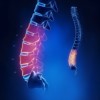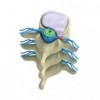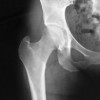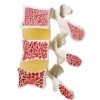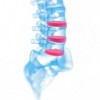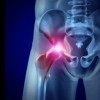Low Back, Pelvis, Groin, Hip & Thigh
Lumbar Degenerative Disc Disease
Lumbar degenerative disc disease known as lumbar DDD is in fact not a disease and medical professionals even debate whether it is in fact a degenerative condition. The misleadingly named diagnosis is used as a term to describe a condition that affects the discs in your spine (not including a disc herniation) and accounts for a lot of back pain cases. It can occur naturally with age; most people over 30 will have some form of disc degeneration present within their spine. Others may experience symptoms at an earlier age, developing after trauma or repetitive injuries to the back.
Initially lumbar DDD presents itself as moderate to severe back pain and stiffness that comes and goes. The pain has been described as a sharp pain, an intense dull ache almost like toothache and also like a burning sensation.
Lumbar radiculopathy also known as sciatica is the medical term referring to pain and the loss of function in a specific region within the legs. This occurs due to irritation or compression of one of the spinal nerve roots in the low back. Lumbar radiculopathy occurs when the space that the spinal nerve travels through, called the intervertebral foramina starts to decrease. There are a few possible causes of this. Symptoms include pain traveling from the low back into a specific region of the thigh, lower leg or foot. In many cases the leg pain is accompanied by numbness, weakness and pins and needles in a similar distribution to the pain.
Hip Flexor Strain - Iliopsoas Strain
A hip flexor strain involves a tear or partial tearing of one or more of the hip flexor muscles causing pain in the groin, hip or front of the thigh. A hip flexor strain is a common injury and effects people of all ages. It is normally seen in individuals who partake in a lot of athletic sports in particular sprinting, hurdles and kicking sports like football and rugby.
Symptoms include a sudden sharp burning pain, along the groin, hip or front of the thigh. In some cases a tearing or snapping noise is heard during the injury. In severe cases a strain will mean that the player or runner is unable to continue. The tear or rupture will be accompanied by severe swelling and bruising that will be incredibly tender to touch.
Adductor strain - Groin strain
An adductor strain also known as a groin strain involves a tear or partial tearing of one or more of the adductor muscles causing pain in the groin and inner thigh. An adductor strain is a common injury and effects people of all ages. It is normally seen in individuals who partake in a lot of athletic sports in particular sports that involve changing direction suddenly like tennis, squash, basketball and rugby.
Symptoms include a sudden sharp burning pain, along the groin or inner thigh. In some cases a tearing or snapping noise is heard during the injury. In severe cases a strain will mean that the player or runner is unable to continue. The tear or rupture will be accompanied by severe swelling and bruising that will be incredibly tender to touch.
A hamstring strain involves a tear or partial tearing of one or more of the hamstring muscles causing pain in the back of the thigh. A hamstring strain is a common injury and effects people of all ages. It is normally seen in individuals who partake in a lot of athletic sports in particular sprinting, hurdles and sports like football, basketball and rugby.
Symptoms include a sudden sharp burning pain, along the back of the thigh. In some cases a tearing or snapping noise is heard during the injury. In severe cases a strain will mean that the player or runner is unable to continue. The tear or rupture will be accompanied by severe swelling and bruising that will be incredibly tender to touch.
Quadriceps Strain - Quad Strain
A quad strain, short for quadriceps strain involves a tear or partial tearing of one or more of the quad muscles causing pain in the front of the thigh. A quad strain is a common injury and effects people of all ages. It is normally seen in individuals who partake in a lot of athletic sports in particular running, sprinting and kicking sports like football and rugby.
Symptoms include a sudden sharp burning pain, along the front of the thigh. In some cases a tearing or snapping noise is heard during the injury. In severe cases a strain will mean that the player or runner is unable to continue. The tear or rupture will be accompanied by severe swelling and bruising that will be incredibly tender to touch.
Osteoporosis is a progressive condition that causes a weakening of the inner structure of the bone. It is a silent and gradual condition that emits no symptoms. There is often no way of knowing you have osteoporosis until you experience a minor fall or knock that results in a fracture, which normal healthy bones would have been able to withstand.
For those who do experience pain it is normally sudden and severe pain with immediate onset after or during the injury. The pain levels are aggravated by any lifting or standing and walking for two long and may be accompanied by intense muscle spasms.
A dislocated hip is the term to describe the displacement of the femoral head (top of the leg) from the hip joint; in essence it is when your hip has popped out of its socket. They are normally the result of traumatic falls or car accidents.
Symptoms will include a sudden and severe pain around the hip joint, across into the groin and down into the leg. Your leg will feel very weak and any leg movement will aggravate the already intense pain levels. Most patients will not be able to weight bear at all on the affected leg and there is normally a degree of hip and leg deformity.
Osteoporosis is a progressive condition that causes a weakening of the inner structure of the bone. Lumbar osteoporosis affects the spinal vertebrae bones of the low back in particular the vertebrae bodies, which form the spinal column. Osteoporosis is a silent and gradual condition that emits no symptoms. There is often no way of knowing you have osteoporosis until you experience a minor fall or knock that results in a fracture, which normal healthy bones would have been able to withstand.
For those who do experience pain it is normally sudden and severe pain in the back with immediate onset after or during the injury. The pain levels are aggravated by any lifting or standing and walking for two long. Flexing and twisting the back is also painful and may be accompanied by intense muscle spasms.
Cauda equina syndrome is the medical term for compression, damage or injury to the portion of nerves at the end of your spinal cord called the cauda equina.
Symptoms include severe and sudden onset of intense low back pain that is normally accompanied by severe sciatica like leg pain, often in both legs. The saddle area around your buttocks will feel numb; patients often report not being able to feel anything when they wipe their bottom. Bowel and/or bladder changes are seen including increased frequency, constipation or even complete incontinence. Cauda equina syndrome is classed as a medical emergency. If you feel you have similar symptoms to the ones just listed it is recommended you seek immediate medical attention.
Rheumatoid Arthritis in the Hip
Rheumatoid arthritis (RA) is a relatively common condition affecting three times more women than men and normally developing between the ages of 40 to 50, although it can affect people at any age. RA has the ability to develop in any joint of the body but most commonly it affects the wrists, hands, ankles and feet. It normally develops symmetrically affecting the same joint on both sides of the body.
Symptoms begin as joint and muscle stiffness, particularly in the early mornings with symptoms starting to ease 2-3 hours after getting up. After a few weeks the same joints that have been stiff may become painful and swollen. The pain will feel like a deep throbbing ache that is aggravated by rest and certain levels of activity. The swelling levels during a flare up also cause the skin around the joint to be extremely tender and slightly warm to the touch.
Slipped Capital Femoral Epiphysis
A slipped capital femoral epiphysis can affect both sides at the same time and most commonly occurs in boys aged 11 -15. In particular it most commonly occurs in children who are obese or very tall and thin going through sudden and rapid growth spurts. It is estimated that the condition affects 2 out of every 100,000 children, making it one of the most common hip complaints in children.
In cases related to trauma the child will feel a very intense, immediate sharp pain around the hip and groin. The child will not be able to weight bear making walking excruciating it may be that one leg is slightly shorter than the other. In the cases where the onset is gradual the child may have been complaining of pain and stiffness around the hip for weeks or months. They might be limping very slightly with the limp worsening as the pain worsens.

